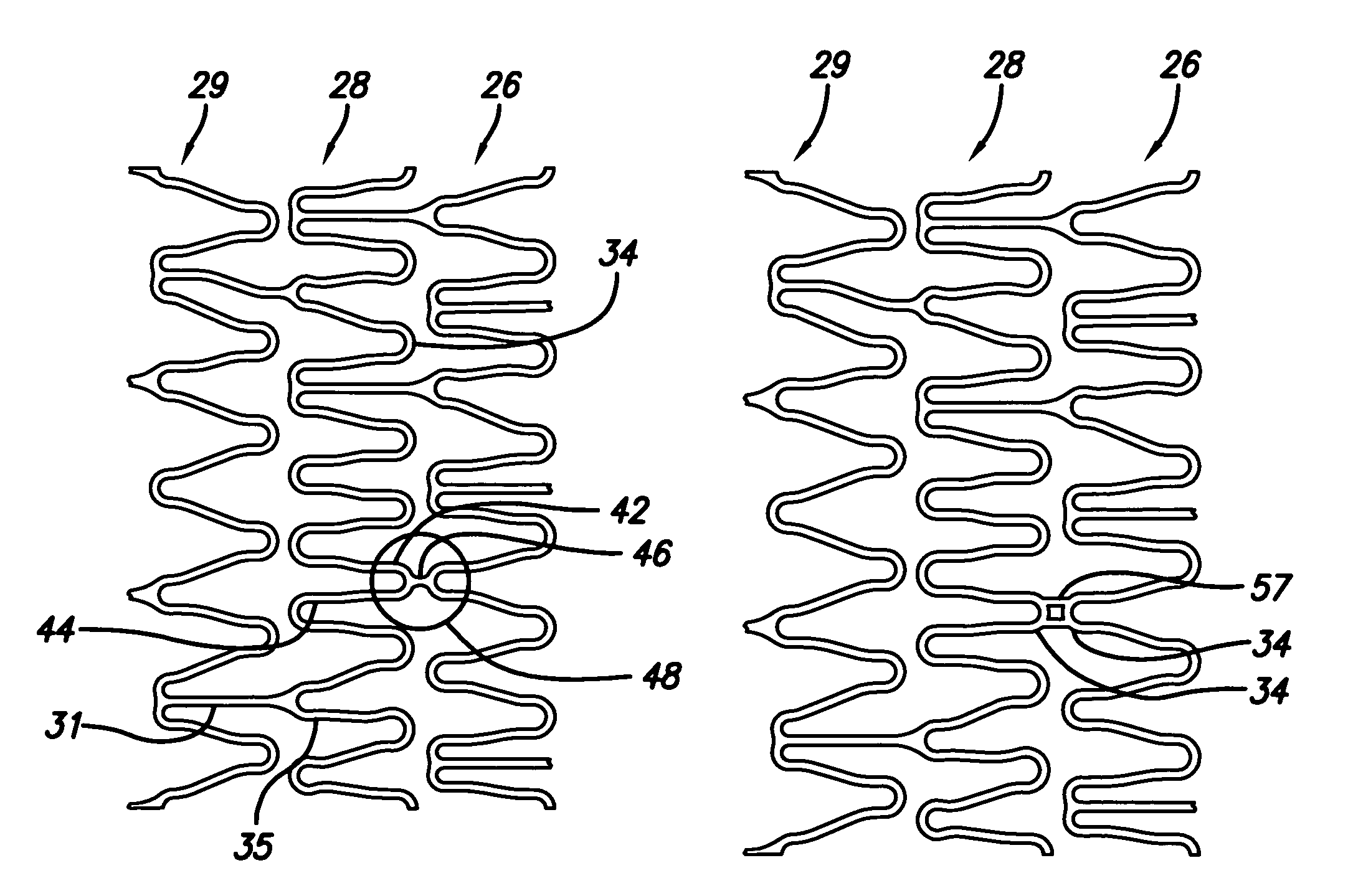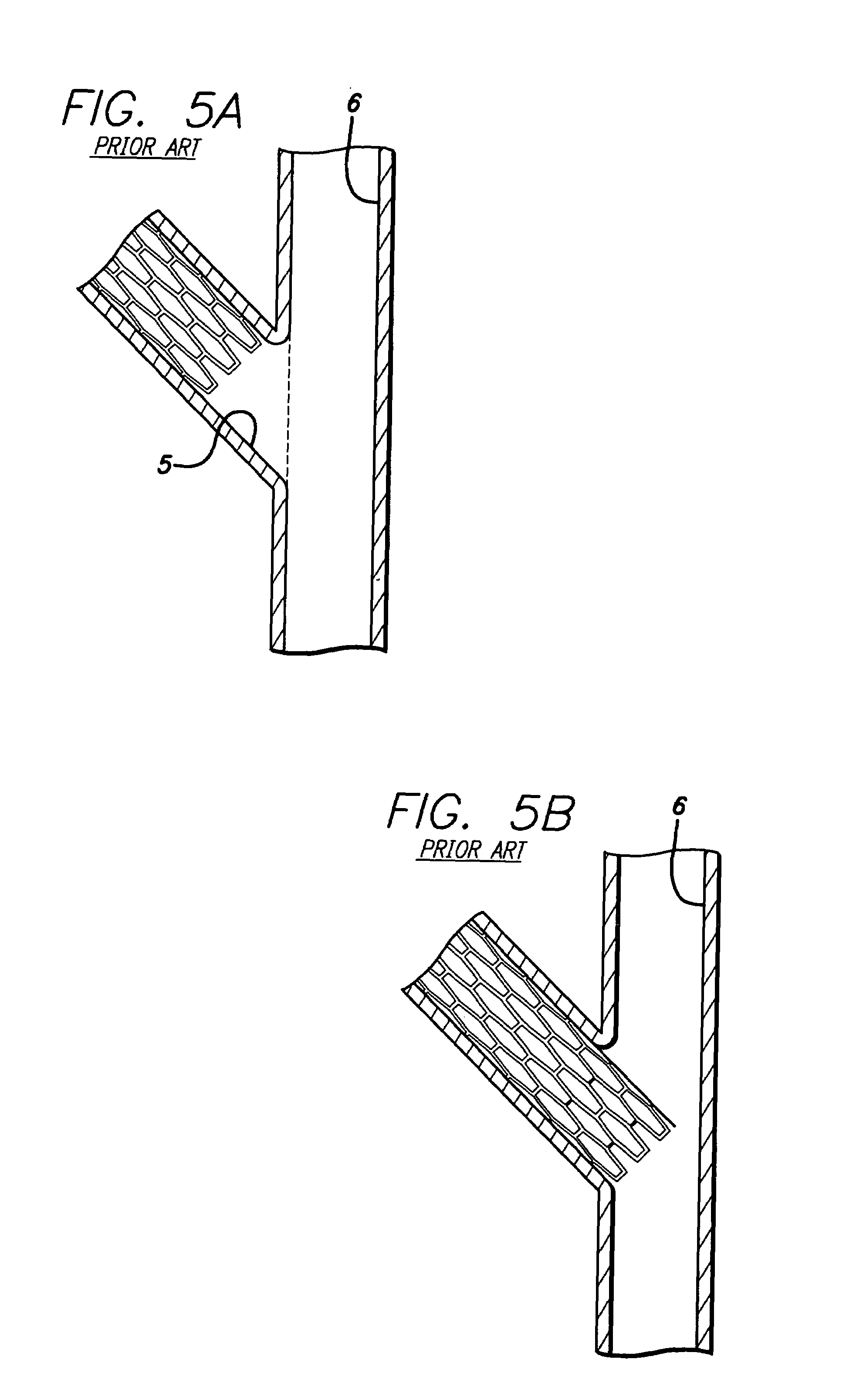Repair of vessels that are diseased at a bifurcation is particularly challenging since the stent must be precisely positioned, provide adequate coverage of the diseased area, provide access to any diseased area located distal to the bifurcation, and maintain vessel patency in order to allow adequate
blood flow to reach the myocardium.
Where the stent provides coverage to the vessel at the diseased portion, yet extends into the vessel lumen at the bifurcation, the diseased area is repaired, but
blood flow may be compromised in other portions of the bifurcation.
Unapposed stent elements may promote lumen compromise during neointimal formation and healing, producing
restenosis and requiring further procedures.
Moreover, by extending into the vessel lumen at the bifurcation, the stent may block access to further interventional procedures.
Conventional stents are designed to repair areas of blood vessels that are removed from bifurcations, and, therefore are associated with a variety of problems when attempting to use them to treat lesions at a bifurcation.
The drawback with this approach is that there is no way to determine or guarantee that the main vessel stent struts are properly oriented with respect to the side
branch or that an appropriate stent
cell has been selected by the wire for dilatation.
The aperture created often does not provide a clear opening and creates a major
distortion in the surrounding stent struts.
A further drawback with this approach is that there is no way to tell if the main vessel stent struts have been properly oriented and spread apart to provide a clear opening for stenting the side
branch vessel.
This technique also causes stent deformation to occur in the area adjacent to the carina, pulling the stent away from the vessel wall and partially obstructing flow in the originally non jailed vessel.
Deforming the stent struts to regain access into the previously jailed strut is also a complicated and
time consuming procedure associated with attendant risks to the patient and is typically performed only if considered an absolute necessity.
The risks of procedural complications during this subsequent deformation are considerably higher than stenting in normal vessels.
The inability to place a guide wire through the jailed lumen in a timely fashion could
restrict blood supply and begin to precipitate symptoms of
angina or even cardiac arrest.
In addition,
platelet agitation and subsequent
thrombus formation at the jailed site could further compromise blood flow into the side branch.
This procedure is also associated with the same issues and risks previously described when stenting only one vessel and deforming the struts through the jailed vessel.
In addition, since a conventional stent generally terminates at right angles to its longitudinal axis, the use of conventional stents to treat the origin of the previously jailed vessel (typically the side
branch vessel) may result in blocking blood flow of the originally non-jailed vessel (typically the
parent vessel) or fail to provide adequate coverage of the
disease in the previously jailed vessel (typically a side
branch vessel).
Such a position of the conventional stent results in a bifurcation that does not provide
full coverage or has a gap on the proximal side (the origin of the side branch) of the vessel and is thus not completely repaired.
One of the drawbacks of this approach is that the orientation of the stent elements protruding from the side branch vessel into the main vessel is completely random.
In addition excessive
metal coverage exists from overlapping strut elements in the
parent vessel proximal to the carina area.
When dilating the main vessel the stent struts are randomly stretched, thereby leaving the possibility of
restricted access, incomplete lumen dilatation, and major stent
distortion.
All of the foregoing
stent deployment assemblies suffer from the same problems and limitations.
Typically, there are uncovered intimal surface segments on the main vessel and side branch vessels between the stented segments or there is excessive coverage in the
parent vessel proximal to the bifurcation.
An uncovered flap or fold in the intima or plaque will invite a “snowplow” effect, representing a substantial risk for subacute
thrombosis, and the
increased risk of the development of
restenosis.
Further, where portions of the stent are left unapposed within the lumen, the risk for subacute
thrombosis or the development of
restenosis again is increased.
The prior art stents and delivery assemblies for treating bifurcations are difficult to use and deliver making successful placement nearly impossible.
Even where placement has been successful, the side branch vessel can be “jailed” or covered so that there is impaired access to the stented area for subsequent intervention.
Further, even with the various patterns of the portal region of a currently manufactured type of bifurcated stent, there is a tendency of the ring or rings of the portal region to immediately overlap with an adjacent ring of the proximal section during
stent deployment.
 Login to View More
Login to View More  Login to View More
Login to View More 


